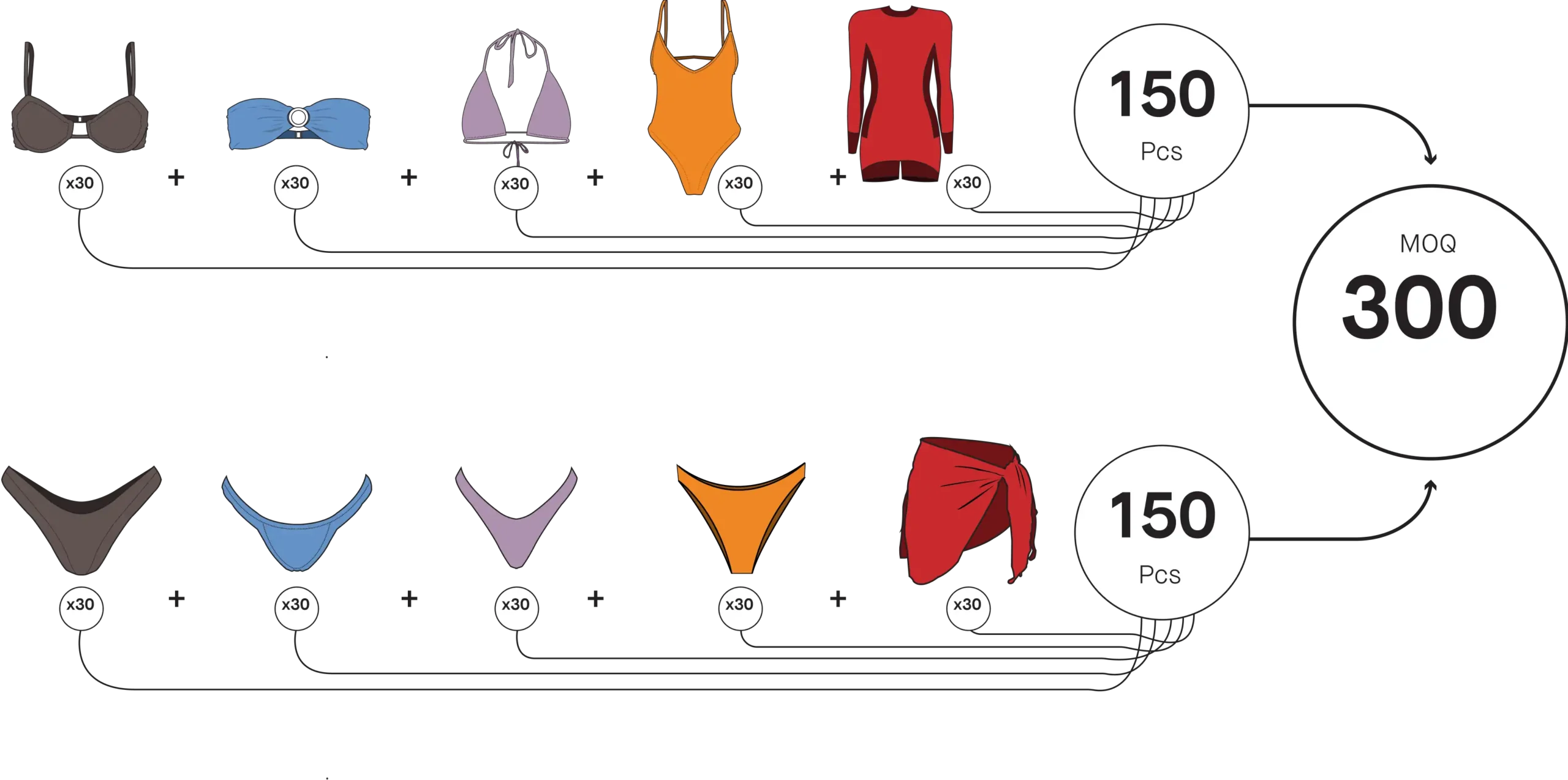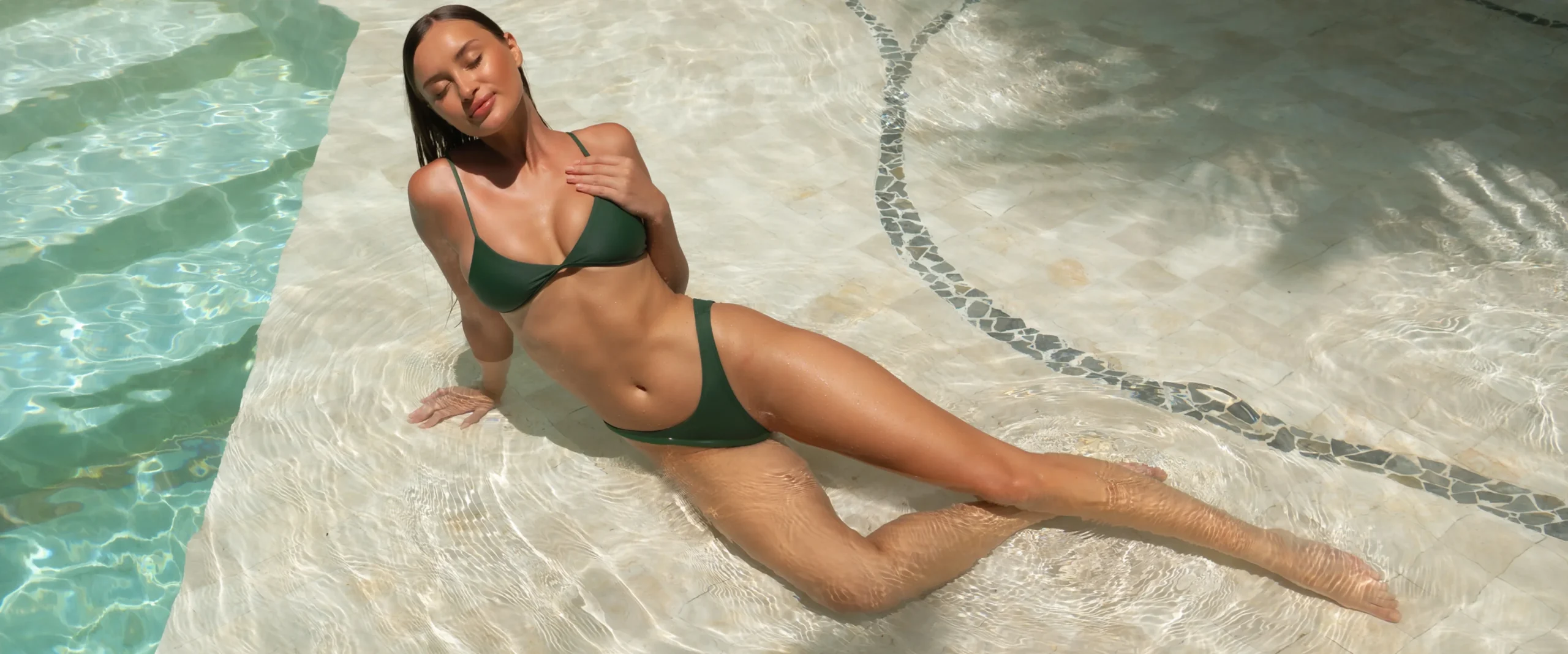What are MOQs?
MOQs, otherwise known as minimum order quantities, are the absolute lowest amount of a product that a manufacturer will accept for a production order. As a low MOQ swimwear manufacturer based in Bali, we’re often asked what these minimums really mean and how they affect new brands.
What the minimums relate to can vary, with some manufacturers requiring an MOQ per style, others total production quantity, or any other variable that the manufacturer sets.
For example, if a manufacturer has an MOQ of 300 pieces total, with 30 per style, you will need to produce a minimum of 30 pieces for each design, for a total of 10 designs, to reach the 300-piece MOQ.

The manufacturer sets MOQs to cover their own costs and make a profit. The lower the MOQ, the less efficient and streamlined the production process becomes, generally leading to higher per-unit costs when using very low MOQ suppliers.
For us at Swimwear Bali, our MOQ is 300 pieces total. Over our 30+ years in the industry, we’ve found this to be the sweet spot for new brands starting out. Anything less than that makes the collection feels a bit limited, not enough styles or sizes to make a strong first impression. At 300 pieces, you can generally have a well-rounded collection while still keeping costs down. It also lets us run production efficiently, so you get the same premium quality and finish we’re known for.

The Product
One of the biggest factors influencing MOQs is the product itself, with varying complexity, material costs and the different levels of technology required.
For example, in the electronics industry, a standard MOQ ranges in the thousands of units due to the complex manufacturing processes involved and the need for specialised components. Manufacturers usually require large orders to justify the setup costs of their production lines and to ensure profitability. Additionally, the demand for smartphones is relatively stable, allowing manufacturers to maintain higher MOQs without risking excess inventory.
On the other hand, in the fashion industry, you can generally find manufacturers with MOQs, even under 100 pieces total. This is partly due to rapidly changing trends requiring manufacturers to be more flexible and responsive. Also, the costs associated with making clothing are generally lower compared to the highly specialised tools and expensive raw materials required for the electronics industry.
As swimwear manufacturers, we’ve designed our systems to stay flexible enough for start-ups to allow smaller runs and have the potential to scale production along with your swimwear brand.
Production Method
Apart from the product itself, the manufacturing method can play a significant role in setting MOQs.
For example, with screen printing and embroidery, if you opt for screen printing, you can easily reproduce complex designs onto fabric just by passing ink through a mesh screen onto the material below. It’s a process similar to creating a stencil, where each colour is applied separately.
On the other hand, if you choose embroidery, the design is meticulously stitched onto the fabric using a needle and thread, creating a textured and durable finish. This method requires precise digitisation of the design and careful manipulation of threads.
The stark contrast in production methods leads to significant differences in Minimum Order Quantities (MOQs). With screen printing, lower MOQs are possible because of the straightforward process and ease of setup. Embroidery on the other hand, typically necessitates higher MOQs to justify the intricate setup and labour-intensive nature of the process.
Market Conditions
Depending on the product, market conditions can play an important role.
In a competitive market where everyone’s fighting for attention, companies might lower their MOQs to attract customers and get ahead of the game. But in less competitive markets, they have more wiggle room to set higher MOQs as customers have fewer competitors.
Apart from the competition, customer demand is also an important factor. For example, demand may fluctuate depending on the seasons, and manufacturers have to consider that and may offer lower MOQs to keep sales volume up.
Customisation
Customisation is another big factor. Making unique items costs money, so companies often need to set higher MOQs for customised items. It’s not just about the product itself; there are often setup costs like making new moulds or tooling. Plus, custom products often need special materials or parts that suppliers have minimum orders for.
How order quantities affect Prices
Order quantities are directly related to the price per item.
Higher quantities almost always mean lower price per unit. This is because higher quantities allow a more efficient production process while also incentivising the consumer to purchase larger amounts.
However, the amount of difference in unit prices between low and high quantities also depends on the product itself. Custom-made products generally have a larger impact than what you could call stock products, as custom products require a personalized service that will increase overheads and possible material costs.

High MOQs
Economics of Scale
Due to economies of scale, high MOQs often lead to lower per-unit production costs. Manufacturers can spread fixed costs, such as setup expenses, over a larger number of units, resulting in cost savings for both parties.
Improved Profitability
Lower production costs associated with high MOQs translate into improved profitability for manufacturers. Higher margins per unit allow companies to increase their bottom line and reinvest in growth initiatives.
Larger Product Range
High MOQs allow companies to have a larger product range, catering to different customer needs and increasing their market coverage. This gives the brand a much better chance to make a name in the industry.
Supplier Relationships
With larger orders, you will have more negotiating power with suppliers, which tends to result in better terms such as lower prices, priority production slots and more.
Inventory Management
For products with predictable demand, high MOQs ensure that stock levels are maintained, reducing the risk of stockouts and the need for frequent reordering. This can save time and administrative costs.
Low MOQs
Less Capital Required
Low MOQs reduce the initial financial commitment required by the business. This means that brands can save the extra money needed for other important factors. This is especially important for startups and smaller businesses with limited funding.
Flexibility in Market Testing
Businesses can try out new products with less risk, this is valuable in dynamic markets where trends are changing rapidly. This lowered risk allows companies to remain innovative and responsive to these changing trends.
Reduced Overstock Risk
With smaller order quantities, businesses are less likely to end up with too much inventory that cannot be sold, which can be costly and take up valuable storage space.
Key takeaways on MOQs
Understanding Minimum Order Quantities (MOQs) is essential for businesses involved in manufacturing and retail. MOQs are the lowest quantity of a product that a manufacturer is willing to produce, and they are set to ensure profitability and cover production costs.
These quantities can vary based on factors such as product complexity, production method, market conditions, and customisation requirements.
High MOQs can lead to economies of scale, improving profitability through lower per-unit costs and enabling businesses to expand their product range. On the other hand, low MOQs offer benefits such as reduced financial risk, greater flexibility in market testing, and a lower risk of overstock. High and low MOQs have strategic advantages depending on a company’s market position and operational goals. Businesses must carefully assess their capacity, market demand, and inventory strategies to determine the most advantageous MOQ that aligns with their objectives and market conditions.
Looking to Start a Swimwear Label?
At Swimwear Bali, we’ve built our reputation as Bali’s leading low MOQ swimwear manufacturer, helping startup labels produce their first collections quickly and professionally. After extensive research and experience, we have determined that a low MOQ of 300 pieces is the ideal starting point for a start-up swimwear brand. This allows your brand to leverage almost all the benefits of both high and low MOQs, giving it the best shot at success at minimal cost.
Apart from this, we own the only complete tax-free import license on swimwear fabrics in Bali, allowing us to import the highest quality fabrics from across the globe whilst keeping costs down.




